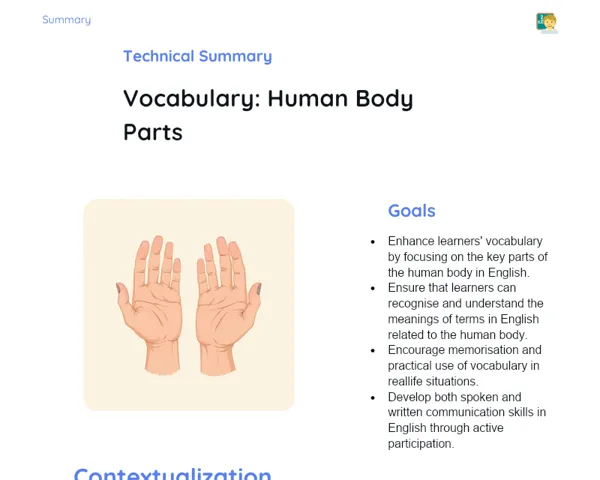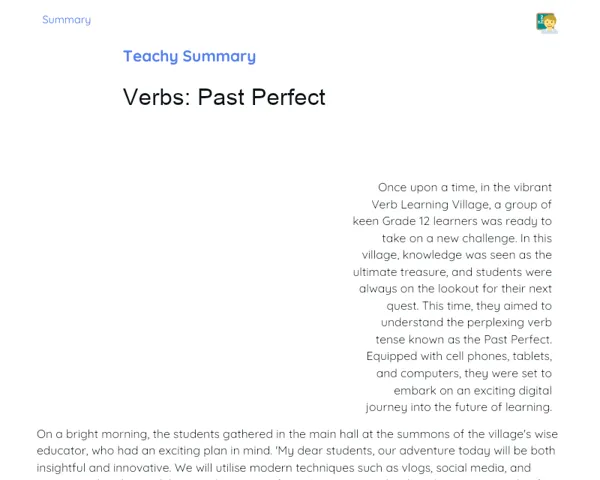Summary Tradisional | Vocabulary: Main Adjectives
Contextualization
Adjectives are vital in constructing sentences as they add extra detail about nouns, enabling richer and more precise descriptions. In English, adjectives are key for effective communication, helping to clarify traits such as quality, quantity, size, and colour. For instance, when we describe a house as 'a big blue house', the adjectives provide the listener with a clear image of what we’re referring to.
Unlike Portuguese, where adjectives generally come after the nouns, in English, they mostly appear before the nouns. This is a critical structural difference for constructing sentences properly in English. Additionally, it’s important for learners to grasp the order of adjectives, especially when more than one is used to describe a noun, as this skill enhances clarity and effectiveness in communication. In this lesson, we will delve into the main adjectives, their classifications, and usage rules to improve students' vocabulary and expression accuracy.
To Remember!
Definition of Adjectives
Adjectives are words that describe or modify nouns, providing additional information about their attributes. They are crucial for detailing and specifying nouns' qualities, making communication richer and more exact. In English, adjectives typically precede the nouns they describe, which differs from Portuguese, where adjectives usually follow nouns.
Adjectives can clarify various traits such as quality, quantity, size, shape, and colour, among others. For example, in 'a beautiful flower', 'beautiful' describes the quality of the 'flower'. Understanding adjectives is essential for constructing meaningful and detailed sentences.
Aside from describing characteristics, adjectives can also express opinions, feelings, and perceptions relating to nouns. They are vital tools in language that add depth and clarity to communication. Therefore, mastering the use of adjectives is an important skill for anyone learning English.
-
Adjectives describe or modify nouns.
-
In English, adjectives usually come before nouns.
-
They can specify quality, quantity, size, shape, colour, and more.
Classification of Adjectives
Adjectives can be categorised based on their specific function in a sentence. Several categories exist, including quality adjectives, quantity adjectives, size adjectives, and colour adjectives. Each category provides a specific type of information about the noun.
Quality adjectives describe the inherent traits of the noun, for example, 'beautiful', 'ugly', 'happy', 'sad'. Quantity adjectives indicate how much of something exists, like 'many', 'few', 'several', 'some'. Size adjectives explain the dimensions of the noun, such as 'big', 'small', 'large', 'tiny'. Colour adjectives specify the colour of the noun, like 'red', 'blue', 'green', 'yellow'.
Understanding these classifications assists students in using adjectives accurately and appropriately, leading to more clear and effective communication. Moreover, recognising various categories of adjectives aids in vocabulary expansion and learning new words.
-
Quality adjectives: describe inherent characteristics.
-
Quantity adjectives: indicate the amount.
-
Size adjectives: describe dimensions.
-
Colour adjectives: specify the colour.
Order of Adjectives
When we use more than one adjective to describe a noun in English, there is a specific order we should generally follow. This sequence is: Opinion, Size, Age, Shape, Colour, Origin, Material, Purpose. For example, in the phrase 'a beautiful large old round red Italian wooden dining table', the adjectives adhere to the proper order.
Following the correct order is important for ensuring sentences sound natural and are easily understood by native English speakers. Disregarding this sequence can lead to confusion or make a sentence sound odd. Thus, it’s vital for students to practise and remember this order to correctly use adjectives in their sentences.
Additionally, the order of adjectives may differ slightly based on context and style in speech or writing. However, the basic sequence mentioned above is a general guideline that promotes clarity and precision in communication.
-
Order of adjectives: Opinion, Size, Age, Shape, Colour, Origin, Material, Purpose.
-
Using the correct order ensures comprehension and naturalness in sentences.
-
Practising and memorising the sequence is crucial.
Comparative and Superlative Adjectives
Comparative and superlative adjectives are used for comparison between two or more things. Comparative adjectives are for comparing two items, while superlative adjectives highlight one item within a group.
To form comparative adjectives in English, we generally add '-er' to the end of the adjective for shorter words (e.g., 'tall' becomes 'taller') and use 'more' before the adjective for longer words (e.g., 'beautiful' becomes 'more beautiful'). For superlative adjectives, we add '-est' to short words (e.g., 'tall' becomes 'tallest') and use 'most' before the adjective for long words (e.g., 'beautiful' becomes 'most beautiful').
Understanding and correctly employing comparative and superlative adjectives allows students to make exact comparisons and articulate degrees of quality or quantity clearly. Practising these forms is crucial for constructing more complex and detailed sentences in English.
-
Comparative adjectives compare two items.
-
Superlative adjectives emphasise one item within a group.
-
Formation: '-er' and 'more' for comparatives; '-est' and 'most' for superlatives.
Key Terms
-
Adjectives: Words that describe or modify nouns.
-
Quality: A classification of adjectives describing inherent characteristics.
-
Quantity: A classification of adjectives indicating the amount.
-
Size: A classification of adjectives describing dimensions.
-
Colour: A classification of adjectives specifying the colour.
-
Order of Adjectives: The sequence in which multiple adjectives should be used to describe a noun.
-
Comparative Adjectives: Forms of adjectives used to compare two items.
-
Superlative Adjectives: Forms of adjectives used to emphasise one item within a group.
Important Conclusions
In this lesson, we explored the significance of adjectives in English vocabulary, highlighting how they describe and add detail to nouns, enriching communication. We understood that adjectives are essential for creating more nuanced expressions, and we learned how to identify and correctly use the main adjectives in English. Additionally, we discussed the specific order of adjectives when used together, which is fundamental for constructing accurate English sentences.
We also reviewed the classification of adjectives, including qualities, quantities, sizes, and colours. This classification aids in using adjectives more precisely and effectively, promoting clearer communication. Furthermore, we delved into comparative and superlative adjectives, used for comparing entities and ensuring correct forms are understood and utilised.
Grasping and correctly implementing adjectives is crucial for any English learner, as it fosters more detailed and precise communication. I encourage you to keep exploring and practising the use of adjectives in various contexts to further improve your vocabulary and fluency in the English language.
Study Tips
-
Practice the order of adjectives by sending sentences that use multiple adjectives to describe a noun.
-
Utilise flashcards to drill the main adjectives and their classifications, along with example sentences.
-
Read English texts and note the adjectives, paying attention to their positioning and function in sentences.



